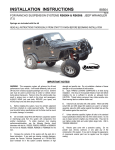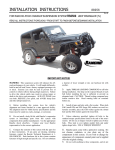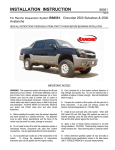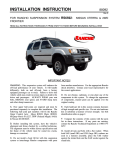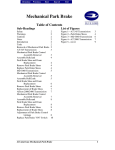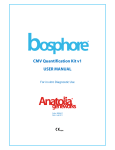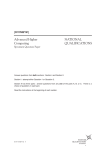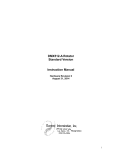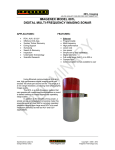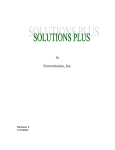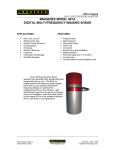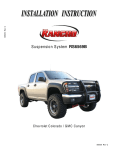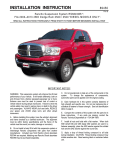Download INSTALLATION INSTRUCTIONS
Transcript
INSTALLATION INSTRUCTIONS 88156 Rev D FOR RANCHO SUSPENSION SYSTEM RS6516 (Rock Crawler Upgrade for the RS6503) READ ALL INSTRUCTIONS THOROUGHLY FROM START TO FINISH BEFORE BEGINNING INSTALLATION USE THIS INSTRUCTION BOOKLET ONLY IF YOU ARE INSTALLING A 6516 KIT TO UPGRADE AN INSTALLED 6503 KIT. IMPORTANT NOTES! WARNING: This suspension system will enhance the off-road performance of your vehicle. It will handle differently, both on and off-road, from a factory equipped passenger car or truck. Extreme care must be used to prevent loss of control or vehicle rollover during abrupt maneuvers. Failure to drive this vehicle safely may result in serious injury or death to the driver and passengers. ALWAYS WEAR your seat belts, REDUCE your speed, and AVOID sharp turns and other abrupt maneuvers. A. Install the RS6516 upgrade kit ONLY on vehicles equipped with the Rancho RS6503 suspension system. Use the following Rancho shock absorbers with this kit: RS5255 or RS9255 for the front & RS5256 or RS9256 for the rear. B. Before installing this system, have the vehicle's alignment and frame checked at a state approved facility. The alignment must be within factory specifications and the frame must be sound (no cracks, damage, or corrosion). C. Do not install a body lift kit with Rancho’s suspension system or interchange parts from this system with components from another manufacturer. D. Compare the contents of this system with the parts list in these instructions. If any parts are missing, including fasteners, contact the Rancho Technical Department at 1-734-384-7804. Each hardware kit in this system contains fasteners of high strength and specific size. Do not substitute a fastener of lesser strength or mix one hardware kit with another. E. Apply THREAD LOCKING COMPOUND to all bolts during installation. One drop on the exposed threads of each bolt before installing the nut is sufficient to provide an adequate bond. CAUTION: Thread locking compound may irritate sensitive skin. Read warning label on container before use. F. Install all nuts and bolts with a flat washer. When both SAE (small OD) and USS (large OD) washers are used in a fastener assembly, place the USS washer against the slotted hole and the SAE washer against the round hole. G. Unless otherwise specified, tighten all bolts to the standard torque specifications listed at the end of the note's section. Do not use an impact wrench to tighten any of these bolts. They tend to over tighten smaller bolts and under tighten larger bolts. USE A TORQUE WRENCH!! H. Rancho parts come with a protective coating. Do not powdercoat, chrome, cadmium, or zinc plate any of the components in this system. If you wish to change the appearance of components enamel paint can be applied over the original coating. I. Do not weld anything to these components, and do not weld any of these components to the vehicle. If any component breaks or bends, contact your local Rancho dealer or Rancho for replacement parts. J. Some of the service procedures require the use of special tools designed for specific procedures. The following tools and supplies are recommended for proper installation of this kit. 5 when you stop during the installation, it will be easier to find where you need to continue from. N. IMPORTANT information for the end user is contained in the consumer/installer information pack. If you are installing this system for someone else, place the information pack on the driver’s seat. Please include the installation instructions when you finish. Jeep Service Manual Spring Compressor Pitman Arm Puller C-4150-A Steering Linkage Puller C-3894-A Drill Motor Drill assortment (1/8” to 1/2”) Torque Wrench (250 FT-LB capacity) Hammer 1/2” Drive Ratchet and Sockets Combination Wrenches Allen Wrenches Torx Key Sockets Hacksaw File Large "C" Clamps and/or Bench Vise Hydraulic Floor Jack Heavy Duty Jack stands Wheel Chocks (Wooden Blocks) Molybdenum Grease or Anti Seize Compound Silicone Spray O. This suspension system was developed using the following tire and wheel combination: 33 x 12.50R-15 tire, 15" x 8" wheel with 3.75" of wheel backspacing. Before installing any other combination, consult your local tire and wheel specialist. P. To achieve maximum articulation, for rock crawling only, disconnect the front sway bar end links. DO NOT OPERATE THIS VEHICLE ON PUBLIC ROADS OR AT SPEEDS GREATER THAN 15 MPH WITH THE SWAY BAR END LINKS DISCONNECTED. Q. Lubricate the following Rancho parts before installation, every 3000 miles, and before every off road use: the lower link bushings , the end link swivels, and the track bar end. Safety Glasses--Wear safety glasses at all times K. It is extremely important to replace torsion bars, CV flanges, and front drive shaft/pinion relationships as original. Be sure to mark left/right, front/rear, and indexing of mating parts before disassembly. A paint marker or light colored nail polish is handy for this. R. Thank you for purchasing the best suspension system available. For the best installed system, follow these instructions. If you do not have the tools or are unsure of your abilities, have this system installed by a certified technician. RANCHO IS NOT RESPONSIBLE FOR DAMAGE OR FAILURE RESULTING FROM AN IMPROPER INSTALLATION. L. Suspension components that use rubber or urethane bushings should be tightened with the vehicle at normal ride height. This will prevent premature failure of the bushing and maintain ride comfort. M. The required installation time for this system is approximately 5 to 6 hours. Check off the box ( 5 ) at the beginning of each step when you finish it. Then Bolt Size 5/16 3/8 7/16 1/2 9/16 5/8 3/4 STANDARD BOLT TORQUE SPECIFICATIONS INCH SYSTEM METRIC SYSTEM Grade 5 Grade 8 Bolt Size Class 9.8 Class 10.9 15 FT-LB 30 FT-LB 45 FT-LB 65 FT-LB 95 FT-LB 135 FT-LB 185 FT-LB 20 FT-LB 35 FT-LB 60 FT-LB 90 FT-LB 130 FT-LB 175 FT-LB 280 FT-LB M6 M8 M10 M12 M14 M16 M18 BOLT IDENTIFICATION 2 5 FT-LB 18 FT-LB 32 FT-LB 55 FT-LB 85 FT-LB 130 FT-LB 170 FT-LB 9 FT-LB 23 FT-LB 45 FT-LB 75 FT-LB 120 FT-LB 165FT-LB 240FT-LB Class 12.9 12 FT-LB 27 FT-LB 50 FT-LB 90 FT-LB 145 FT-LB 210 FT-LB 290 FT-LB PARTS LIST P/N 170081 170082 176083 176084 176085 176086 176088 176089 176180 602612 602615 7727 860070 860086 170078 860155 420088 545 DESCRIPTION Right Brake Line Left Brake Line Center Section, Front End Link Bottom Socket, Front End link Bracket, Front End Link Track Bar Rear End Link Front Bump Stop Perch Suspension Link Track bar End (Ball joint) Top Swivel, Front End Link Pitman Arm Shim Kit Washer Gasket Kit Brake Line Gasket Rear End Link Hardware Kit Sleeve, Rear End Link Bushing 7/16-20x2.5 HHCS 7/16-20 Stover Nut 7/16 SAE Washer 7/16 USS Washer P/N 860157 420086 520086 QTY. 1 1 2 2 2 1 2 2 4 1 2 1 1 16 1 4 1 4 4 4 4 4 6 860218 420080 520080 860561 420084 545 770057 94180 780281 88156 94119 94177 3 DESCRIPTION Front Track Bar Hardware Kit Sleeve Bushing 3/8-16 x 1.5 HHTS 3/4-16 Jam Nut Cotter Pin Articulation Bushing Kit Sleeve Bushing Quick Disconnect Hardware Kit Sleeve, Front End Link Bushing Lynch Pin Assembly 3/4 Rubber Washer 10mm Washer 1/2-20 x 1.75 HHCS 1/2-20 x 2.75 HHCS 1/2-20 Nyloc Nut 1/2 SAE Washer 1/2 USS Washer Information Pack Rancho Decal Instructions Consumer/Warranty Information Warning Sticker QTY. 1 1 2 2 1 1 1 8 16 1 2 2 2 4 2 2 2 4 4 4 1 1 1 1 1 2) Utilizing a straight edge, measure the horizontal distance between the outer edge of each front tire and the vehicle body (at top edge of fender well). RANCHO LINK ASSEMBLY BUSHING & SLEEVE INSTALLATION 1) Lubricate the outside diameter of two urethane bushings (part No. 520080) with a silicone spray or a mild solution of soap and water. Left Side:_________ Right Side:_________ 3) Remove the cotter pin and nut from the ball stud end of the track bar at the frame rail bracket. Separate the ball stud from the bracket with the recommended puller tool. See figure 2. 2) Press the lubricated bushings into one end of a new Rancho cast link (176180) as shown in figure 1. 3) Lubricate the outside diameter of sleeve 420080 and the inside diameter of the installed urethane bushings. Press the sleeve into the bushings. Figure 2 Figure 1 4) Remove the bolt and flag nut from the axle bracket. Remove the track bar. NOTE: It may be necessary to use a bench vise or Cclamp to press the bushings and sleeves into the lower links. Do not use a hammer. 5) From inside the engine compartment, remove the upper stud nut, retainer and grommet from both front shock absorbers. 4) Slowly apply grease to each end of the lower links (through the grease fitting) with a grease gun. Stop when the grease begins to appear around the edges of the bushings. Do not force the bushings out of the link. 6) Raise the front of the vehicle and support the frame with jack stands. Remove the front wheels and set them aside. 7) Position a floor jack under the front axle for support. Remove both front sway bar end links. See Figure 3. 5) Repeat steps 1 through 4 for the remaining lower link ends, bushings, and sleeves. 8) FRONT SUSPENSION Lower axle and remove floor jack. 9) Remove the shock absorber lower nuts and bolts. Remove the front shock. DO NOT REUSE ORIGINAL SHOCK ABSORBERS. TRACK BAR & COIL SPRING REMOVAL 1) Park vehicle on a level surface and set the parking brake. Center front wheels and chock rear wheels. 10) Remove the rubber bump stop and bump stop mount from inside of the coil spring. 4 4) Remove the nut, cam, and cam bolt from the axle bracket. Remove the nut and bolt from the frame bracket. Remove the lower suspension arm. See Figure 5. Figure 3 11) Remove the coil spring retainer bolt and retainer. Push down on the axle and remove the coil spring. 12) Repeat steps 9 through 11 for other side. Figure 5 5) Install new Rancho cast link 176180, along with four shims from kit 860070, to the frame and axle brackets as shown in figure 6. Use original hardware but do not tighten. LOWER ARM REMOVAL & LINK INSTALLATION 1) Support the front axle with a floor jack. 2) Paint or scribe alignment marks on the adjustment cams and axle brackets for installation reference. See Figure 4. Figure 6 Figure 4 6) 3) If equipped with ABS brakes, remove sensor wires and clamps from the inboard side of the lower arms. Save clamps for reuse. Repeat steps 4 and 5 for the other side. 7) If applicable, drill a 23/64" hole into each lower link and reinstall the ABS sensor wires. Use the original clamps. NOTE: Remove and replace one suspension arm at a time. 5 5) Rotate spring so pig tail end fits back in spring pocket. Reinstall the rubber bump stop. PITMAN ARM REPLACEMENT 1) Remove the cotter pin and nut from the drag link at the pitman arm. Separate the drag link ball stud from the pitman arm with a puller tool. Do not use a pickle fork. 6) Repeat steps 2 through 5 for other side. BRAKE HOSE REPLACEMENT 2) Center the steering wheel and mark the position of the original pitman arm. Remove the nut and washer from the steering gear shaft. NOTE: To keep the brake bleeding process to just the front calipers, do not allow the brake fluid to drain completely from the master cylinder reservoir. 3) Remove the pitman arm from the steering gear with pitman arm puller C-4150-A. 1) Separate the left front brake hose from the brake tube and the frame rail. Plug tube to prevent brake fluid leakage. 4) Align and install new pitman arm 7727 on the steering gear shaft. Install the washer and nut. Tighten the nut to 185 ft. lbs. 2) Remove the brake hose from the caliper. Discard copper washers. 5) Install the drag link ball stud to the pitman arm. Install the nut and tighten to 60 ft. lbs. Install a new cotter pin. 3) Attach left brake hose RS170082 to the caliper with NEW copper washers from kit RS860086, and the original bolt. See figure 8. Tighten the bolt to 23 ft.-lbs. COIL SPRING INSTALLATION 4) Attach the new brake hose to the frame and brake tube. Tighten securely. 1) Lower the front axle and remove the hydraulic floor jack. 5) Repeat steps 1 through 4 to install right front brake hose RS170081. 2) Drill a 5/16" hole through the center of the coil spring axle pad. Attach the bump stop perch 176089 to the axle pad with the longer self-tapping screw from kit 860156. 3) Compress coil spring (615) to 16" in length. Use a quality spring compressor like the one shown in figure 7. Figure 8 Figure 7 6) Refill the master cylinder reservoir with approved brake fluid and bleed the front brakes as follows: • Attach a clear hose to the right front caliper bleeder screw and immerse the other end into a container of clean brake fluid. 4) Place the rubber bump stop inside the compressed spring. Install the spring into the upper and lower spring pockets. Carefully remove the spring compressor. 6 SWAY BAR END LINK & SHOCK INSTALLATION • Loosen the bleeder valve on the caliper. • Have an assistant push the brake pedal down and then hold. • Tighten the bleeder valve and slowly release the pedal. • Repeat the procedure until all air is purged from the caliper. • Attach the hose and container to the left front caliper and repeat the bleeding process. Refill the brake master cylinder reservoir as necessary. 1) Support the front axle with a floor jack. 2) Loosely attach end link bracket 176085 to the axle bracket with hardware from kit 860159. See figure 10. SWAY BAR END LINK ASSEMBLY 1) Apply silicone lubricant and press a bushing from kit 860159 into a front end link bottom socket (176084). 2) Apply silicone lubricant and press a sleeve from kit 860159 into the installed bushing. Figure 10 3) Install a rubber washer (770071) onto each end of center section 176083. 3) Loosely attach a new end link assembly to the installed bracket with hardware from kit 860159. 4) Connect the bottom socket assembly to a top swivel (176082) with the center section. Insert a set of locking pins (770057) as shown in figure 9. 4) Insert the top swivel of the link assembly into the sway bar. Install the supplied nut and tighten to 45 ft. lbs. 5) Grease the top swivel. Push down on the ball stud when applying grease for the first time. Stop when grease flows past ball. 5) Drill a 17/64” hole in fender support as shown in figure 11. Figure 11 Figure 9 6) 6) Repeat steps 1 through 5 to assemble the other end link. 7 Repeat steps 2 through 5 for other side. 7) Grind the passenger side axle bracket even with end link bracket 176085. See figure 12. 2) Apply silicone spray and press the bushings and sleeve from kit 860157 into the track bar assembly. 3) Loosely attach the new track bar to the axle bracket with the original bolt and flag nut. 4) Temporarily attach the track bar end to the frame rail bracket. 5) Repeat tire to fender well measurements (refer back to step 2 under TRACK BAR REMOVAL). If necessary, adjust the track bar end to duplicate the previously measured difference. Tighten the jam nut. 6) Tighten the track bar to axle bracket mounting bolt to 55 ft. lbs. and the ball stud nut to 65 ft. lbs. Install a new cotter pin. Figure 12 8) Install one retaining washer and grommet onto each new front shock absorber. Attach shocks to axle brackets. Tighten bolts to 23 FT-LBS. REAR SUSPENSION END LINK & SHOCK ABSORBER REMOVAL 9) Install front wheels and lower vehicle to the ground. Tighten lug nuts to 80--110 FT-LBS. 1) Chock front wheels. Disconnect and remove the rear sway bar end links. 10) Position shock stud through upper mounting hole. Install upper shock grommet, retainer and nut. Tighten to 17 FT-LBS. Repeat for other side. 2) Raise the rear of the vehicle and support the frame with jack stands. Remove the rear wheels. 11) Tighten the sway bar lower link bolts to 70 FTLBS. 3) Support the rear axle with a floor jack and remove the shock absorbers. DO NOT REUSE ORIGINAL SHOCK ABSORBERS. 12) Tighten the lower suspension arm to frame bracket nut and bolt to 130 FT-LBS (both sides). LOWER ARM REPLACEMENT 13) Align the reference marks on the adjustment cams and lower arm axle brackets. Tighten nuts to 85 FT-LBS. NOTE: Remove and replace one suspension arm at a time. 14) Apply grease to the new lower suspension arms and the top swivel of the sway bar end links. DO NOT OVER GREASE! 1) Remove the lower arm axle and frame mounting bolts. Remove the lower suspension arm. TRACK BAR INSTALLATION 2) Install new Rancho cast link 176180, along with four shims from kit 860070, to the frame and axle brackets. See figure 13. Use original hardware but do not tighten. 1) Install the jam nut from kit 860157 on the new track bar end (602612). Thread the end assembly into the new track bar (176086) until only four threads are exposed. Do not tighten the jam nut. 8 5) Install new Rancho shock absorbers to the upper frame rail. Tighten mounting bolts to 23 ft. lbs. Loosely attach shocks to the axle brackets. 6) Install rear wheels and lower vehicle to the ground. Tighten lug nuts to 80--110 ft. lbs. 7) Tighten the end link mounting bolts to 40 ft. lbs. and the lower shock mounting bolts to 74 ft. lbs. 8) Tighten all lower arm mounting bolts to 130 ft. lbs. 9) Grease new lower suspension arms until you see a slight amount of grease coming out of bushings. DO NOT OVER GREASE! Figure 13 3) Repeat steps 1 and 2 for the other side. FINAL ASSEMBLY END LINK & SHOCK ABSORBER INSTALLATION CHECKS & ADJUSTMENTS 1) Apply silicone lubricant and press a bushing from kit 860155 into a new rear end link (176088). 1) Turn the front wheels completely left then right. Verify adequate tire, wheel, and brake hose clearance. Inspect steering and suspension for tightness and proper operation. 2) Apply silicone lubricant and press a sleeve from kit 860155 into the installed bushing. 3) Repeat steps 1 and 2 to install the rest of the bushings and sleeves. 2) With the suspension at maximum extension (full droop), inspect and rotate all axles and drive shafts. Check for binding and proper slip yoke insertion. The slip yoke should be inserted a minimum of one inch into the transfer case and/or transmission 4) Loosely attach the new end link assemblies to the frame brackets and rear sway bar with the hardware from kit 860155. See Figure 14. 3) Ensure that the vehicle brake system operates correctly. If new brake hoses were installed, verify that each hose allows for full suspension movement 4) Readjust headlamps. Have vehicle Aligned to manufacturer’s specifications. Alignment Specifications ADJUSTMENT Caster Camber (fixed angle) Toe-In (each wheel) Thrust Angle Figure 14 NOTE: It may be necessary to enlarge the mounting holes in the sway bar and frame brackets to 7/16”. 9 PREFERRED 7° -0.25° 0.15° 0 RANGE ±1.0° ±0.63° ±0.15° ±0.15° END LINK QUICK DISCONNECT PROCEDURE (FOR CRAWLING ONLY) ROCK 1) Remove the hitch pins and center sections from the front sway bar end links. Place center sections inside vehicle for safe storage. 2) Rotate the sway bar upward. 3) Connect the sway bar to the inside of the fender wells as shown in figure 15. Use the drilled hole (from figure 11) and the hitch pin assemblies. Figure 15 IMPORTANT NOTICE WARNING: DO NOT OPERATE THIS VEHICLE ON PUBLIC ROADS OR AT SPEEDS GREATER THAN 15 MPH WITH THE SWAY BAR END LINKS DISCONNECTED. Please retain this publication for future reference. See Important Note N. 10










